From: News@PeopleForCleanBeds.org [mailto:News@PeopleForCleanBeds.org]
Sent: Sunday, July 15, 2007 7:42 PM
To: mark@strobel.com
Subject: Chicago Tribune article and TV news nationwide on toxic mattresses
Chicago Tribune 7/1/07 & TV Nationwide about Toxic Beds
With the July 1 fireproof (toxic) mattress deadline we have received some major news from newspapers and TV stations across the country.
The Chicago Tribune did a great 2200 word investigative feature article article on Sunday July 1. Karen Klages (who we hope you will nominate for awards) exposed many risks of the regulation. She got admissions from industry and top manufacturers that they really are using toxic chemicals to flameproof mattresses including, Antimony Trioxide, Boric Acid (Roach Killer), Silica Glass, and Ammonium Polyphosphate. Plus she quoted several top scientists and doctors who say this is unsafe. Karen also told people there is an alternative in prescription mattresses that are toxin free and avoid the regulation.
TV news stories have run so far on CBS, NBC, and FOX in about twenty cities including New York NY, Tampa FL, Denver CO, Indianapolis IN, Minneapolis MN, Milwaukee WI, and Louisville KY (3 networks) to name a few. These stories include video interviews of me (Mark Strobel), people sick, mattress manufacturer employees sick, and Dr. Doris Rapp, MD who warns this chemical use is very risky. (Links to these video clips and newspaper stories below)
From Chicago Tribune, Selected Quotes from their article titled:
New flammability regulation for mattresses, renewed concerns about chemicals
By Karen Klages
Chicago Tribune staff reporter
July 1, 2007
"Where there is fire, though, there is haze.
The development is not without debate.
Some doctors, scientists and at least one mattress manufacturer see red flags in introducing to the home front yet another usage of flame-retardant chemicals, which already are in a range of consumer products, from electronics to paint and furniture.
Some of them believe it could be the tipping point for people who are chemically sensitive. Others think it's unfair to expose all Americans to these chemicals and materials when a small percentage of people actually die in fires that start with a mattress.
For its part, the mattress industry (which didn't fight the regulation; many manufacturers view the new flame retardancy as a major product improvement -- and as a significant bit of protection for themselves from liability suits) ...
Some troublesome FR chemicals have been identified as bioaccumulators, which means they persist in the environment. Or: suspected developmental toxicants, which means they could harm developing fetuses. And even: suspected carcinogens. ...
... this new regulation, which will affect all Americans buying mattresses, except those who get a doctor's prescription. With that, a consumer can have a one-of-a-kind mattress made, minus the flame retardants. ...
How mattress manufacturers achieve this feat of fire performance is largely left up to them. ...
"Nobody can really find out what's in their mattress. That's one of the big issues." For someone who is chemically sensitive, this is critical information, Heine says.
Trainer said some mattress-makers may be using antimony trioxide in their fire barriers ... (Antimony trioxide has been identified as a probable carcinogen.)
Representatives from Sealy, Serta, Simmons and Spring Air -- four of the five largest bedding makers in the country -- are tight-lipped about the exact nature of their fire barriers. (Tempur-Pedic, rounding out the Top 5, would not reveal any information about its flame-retardant program. Those five manufacturers represent about 60 percent of all mattresses sold in the U.S.) ...
Sealy, Serta and Spring Air (Simmons would not offer specifics) all are using one (or more) of three fire barrier technologies or some variation of them.
They involve: barriers made from mainly cotton that has been bonded with boric acid; barriers made of rayon that has been extruded with silica (tiny fragments of glass or clay); and barriers made from rayon that has been treated with ammonium polyphosphate.
... it may be missing the point with chemically sensitive people. According to Dr. William Rea, a Dallas-based surgeon-turned-environmental medicine doctor, the concept of "total load" is key.
"Total load means that the body has a capacity to hold [only] so many incitants -- any substance that can cause disease," says Rea, who notes that the number of chemically sensitive people not just in the U.S., but around the world, is growing and attributes that to the rise of toxic chemicals in our air, food and water. "More and more people are getting overloaded."
He goes on: "Picture a barrel. Each person is a barrel. Once the barrel gets full, that's the essence of total load. One more drop [one more chemical exposure], and it spills over into trouble."
That trouble could be problems with the immune system, the non-immune enzyme detoxification system and the autonomic nervous system, says Rea, noting that he has not studied the new flame-retardant mattresses or what's in them.
But, Rea calls the home "probably the most contaminated of any place in our environment." He notes "gas stoves, pesticides, synthetic carpets, synthetic mattresses and cleaning products" -- and the fact that many homes are made to be so airtight that they don't breathe.
Rea sees several thousand patients from around the world annually at his Environmental Health Center in Dallas, where he puts chemically overloaded patients through a detox program that includes exercise, sauna, a special nutrition program and sleeping in "environmentally less polluted" rooms, which have ceramic tile floors and (sometimes) walls, organic cotton mattresses and organic cotton bed linens.
Chemically sensitive people aren't the only ones at risk from chemical overload, according to Dr. Doris Rapp, a pediatrician, allergist and environmental medicine doctor based in Arizona. Children, pregnant women and the elderly are other high-risk groups -- and product testing is rarely done on them, Rapp says.
What else can you do?
Consumers who want to purchase a mattress without the new flame retardants are left with few choices.
Mark Strobel, a small mattress-maker in southern Indiana who has launched an Internet campaign (www.peopleforcleanbeds.org ) against the new federal regulation also has launched a new Internet-based business, www.prescriptionbeds.com . He will make consumers a bed without the new flame retardants, with a doctor's prescription, as the regulation allows. Consumers can purchase online or through a network of furniture and bedding stores around the country, as well as through chiropractors.
<End of Chicago Tribune quotes>
Industry and US Consumer Products Safety Commission (CPSC) Doubletalk
There are two, and only two, ways to make a fiber fire resistant. 1) You coat it with chemical. 2) You use an inherently fire resistant fiber that contains fire retardant chemicals blended into the fiber itself.
Industry doubletalk's this issue by saying, “We don’t spray on or apply chemicals, we use inherently fire resistant fibers.” CPSC admits chemicals are used but says many manufacturers use chemical free systems (inherently fire resistant fibers).
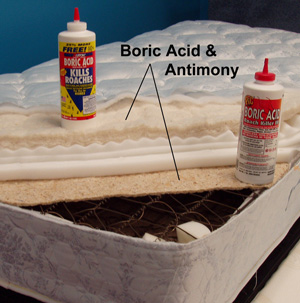
The cotton system uses boric acid [Roach Killer] and inherently fire resistant fibers (Modacrylic, that contains Antimony Trioxide blended into the fiber itself) blended with the cotton to form the fire barrier. CPSC Table 1, item 1.
Another popular system they usually call Rayon and say it is inherently fire resistant fibers without chemical treatment. In fact it contains chemicals in the fiber. At the very least these fibers also called Visil contain Silicon (Silica Glass), PVDC, and probably Ammonium Polyphosphate as well. You can see these fiber systems and chemical content in CPSC Table 1, items 3, 4, 5.
Like Asbestos chronically breathing tiny particles of Silica Glass may also be a health risk.
Most likely the Rayon systems being used also contain Modacrylic fibers that contain Antimony Trioxide, CPSC Table 1, items 2 and 6. You can see in the table these barrier systems contain 3.8% or 4.5% Antimony Trioxide. This is a lot of poison.
The 20 Simmons employees who are complaining of respiratory problems and skin rashes are handling one of these systems the manufacturers try to claim is inherently fire resistant fibers and chemical free.
The CPSC measured the amount of Antimony that leaches to the surface of mattresses from these inherently fire resistant fibers.
The CPSC assumed without data that we would only absorb 2/1,000’s of the Antimony that has leached to the surface and contacts our skin. Using this low assumption the CPSC says we will absorb .8 mg of Antimony every night. Even .8 mg of Antimony is 27 times more that the EPA says is safe to absorb.
Antimony absorbs readily through the skin as demonstrated by research showing 6 to 8 skin applications of Antimony Trioxide in a mixture resembling sweat killed half the rabbits studied. Studies also showed Antimony oral absorption caused lung cancer. Another inherently fire resistant fiber, Melamine Resin, contains free Formaldehyde. Formaldehyde concentrations of only 10 to 15 parts per million has been shown to cause nasal cancer in rats chronically exposed. What will these chemicals do to humans with many years of exposure?
Boric Acid (Roach Killer) is simply mixed as loose dust with the cotton fibers. The CPSC assumed we would absorb only less than 1/10,000's of the Boric Acid they measured leached to the surface and contacts our skin to predict we will absorb .081 mg every night. The CPSC also measured DBDPO leaching and says we will absorb .073 mg with a 1/1,000's skin absorption assumption. These assumptions seem very low and show this study was designed to reach a preexisting conclusion. There is a lot of toxic chemical on the surface of mattresses.
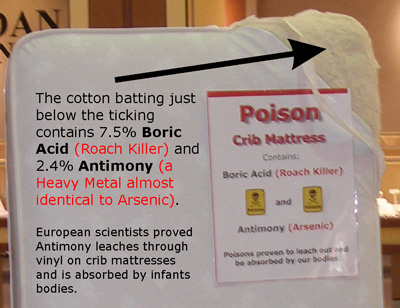
Even Crib Mattresses now contain Antimony and Boric Acid to meet the regulation. European scientists proved Antimony leaches through vinyl on crib mattresses.
You can see from the above there are no magic fire barrier systems that are chemical free. They all contain toxic chemicals including the inherently fire resistant fibers, and it is proven we will absorb these chemicals every night.
If mattresses alone aren’t bad enough the CPSC will soon enact a national rule that all upholstered furniture be flameproof and require the same chemical barrier systems used in mattresses shown in CPSC Table 1. Plus California has already passed a law that requires bed clothes also be flameproof and is waiting on the bureaucracy to finalize the rule. The CPSC is already working on a new regulation that will require our bed clothes, filled items including mattress pads, comforters, and pillows, to also be flameproof. This will again require the same chemicals used to flameproof mattresses be used. This regulation is expected to pass within a short time. By then the only time we won’t be absorbing toxic chemicals is when we are standing up.
We pollute the environment, now we are polluting our beds.
We hope you will do a story.
Feel free to call me at 800-457-6442, or email mark@strobel.com .
Sincerely,
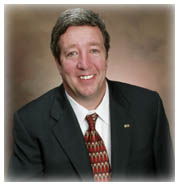
Mark Strobel, Director, www.PeopleForCleanBeds.org , President, Strobel Mfg. www.Strobel.com , www.PrescriptionBeds.com , 3131 Industrial Pkwy, Jeffersonville IN 47130, email: Mark@Strobel.com , fax: 812-282-6528, phone: 812-280-6000
If you are not the right person please forward this email to the people in your organization who might do a story.
Additional Links:
TV news video clips, Magazine, and Newspaper Stories about us including Chicago Tribune, Washington Post, and more
http://www.prescriptionbeds.com/making_news.htm
CPSC Table 1 of Chemicals really used to fireproof mattresses:
http://www.prescriptionbeds.com/chemicals-in-beds.htm
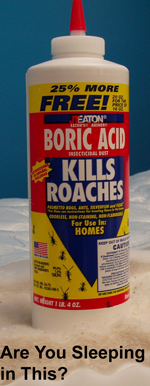
Proof of Claims: See these facts and more firsthand in government documents at:
http://www.peopleforcleanbeds.org/CPSC_Risk_Assessment_Highlights_w-notes_v2.pdf
Doctor, Public, and Retailer Comments:
http://www.peopleforcleanbeds.org/retailer-comments.htm
Boric Acid Health Risks:
http://www.peopleforcleanbeds.org/boric_acid_risks.htm
Antimony Health Risks:
http://www.peopleforcleanbeds.org/antimony-risks.htm
Pounds of Poison in Crib and Adult Mattresses:
http://www.prescriptionbeds.com/Pounds%20Boric%20Acid.htm
Proponents Say and Rebuttals:
http://www.prescriptionbeds.com/Proponents-Say.htm
Strobel's History of Fighting the Regulation
http://www.peopleforcleanbeds.org/fight_history.htm
Comments of People Sick from fireproof mattresses:
http://www.peopleforcleanbeds.org/People-Sick.htm
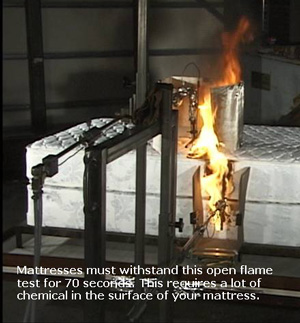
Mark Strobel, Director, www.PeopleForCleanBeds.org , President, Strobel Mfg. www.Strobel.com , www.PrescriptionBeds.com , 3131 Industrial Pkwy, Jeffersonville IN 47130, email: Mark@Strobel.com , fax: 812-282-6528, phone: 812-280-6000
If you are not the right person please forward this email to the people in your organization who might do a story.
This email news release is intended for news media and writers only. If you received in error or wish to be removed from list, please reply to this message with the word "Remove" in the subject line.
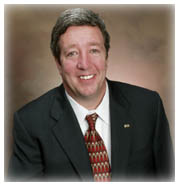
No comments:
Post a Comment